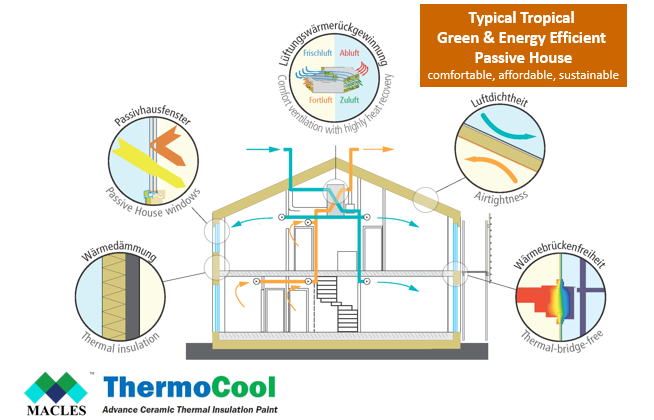
Passive House- Doing more with less
What is passive about a Passive House?
A Passive House requires very little energy to maintain a constant, pleasant temperature. In this sense, such buildings are almost “passive” as they need hardly any active heating or cooling to stay comfortable year-round. Excellent insulation and highly efficient heat recovery systems make this possible. Passive design principles are well known in engineering as effective strategies to achieve a goal with little to no input. Passive security, passive filters, passive cooling and Passive House are examples of the successful implementation of this idea. Of course, none of the aforementioned applications are completely passive in the strict sense of the term as they each require a minor amount of input to guide the respective processes along the desired course. The concept is not as much about letting things happen without using any energy, though, as it is about intelligent design: reaching the desired goal with minimal use of complex systems and non-renewable resources.
Benefits of Passive House
Increase Property Value
A certified Passive House is more desirable in the market due to its high performance characteristics
- Higher property value
- Slower depreciation rate
Lower Utility Bills
Passive House are extremely energy efficient and will help the occupants to save money throughout the lifetime of the building.
- Lower monthly electricity bill
- Reduce or Remove heating/cooling equipment usage, less yearly maintenance costs
Good for The Earth
Everything about the Passive House aims to solve global environmental problems.
- Lower Ecological Footprint
- Work with what nature provides and not against it
Higher Quality of Life
No matter what the outside conditions are, Passive Houses ensure that the indoor environment remain comfortable and clean.
- Optimum air temperature
- Dust-free, Pollutant-free, Bacteria-free air
- Increase work productivity
Versatile Construction
The Passive House standard is based purely on building performance and quality and therefore it does not specify any particular methods of construction. Whether it is solid construction, wood or composite, architects are free to be creative with their Passive House designs. It is a very versatile concept which is applicable to all building types in all climate regions.
How is the Passive House Design in Tropical Climate?
1. Building Envelope
Insulated Walls, Roofs and Double Glazed Low-E Windows will reduce external heat penetration while maintain cool temperatures to the building interior
2. Building Orientation
Buildings facing the North/South direction will minimize solar exposure on the wall
3. Air Tightness
An airtight building envelope will prevent infiltration of warm, humid and polluted air, whilst maintaining the cool indoor temperature
4. Shading
External shading (fixed or movable) will stop direct solar heat gains inside the building through the windows.
5. Dehumidification
Energy Recovery Systems will dehumidify the supply air reducing latent cooling load and ensuring dry indoor air – comfort and prevention of mold growth.
6. Efficient Ventilation
A constant supply of fresh air keeps the indoor environment healthy. Outside air is filtered, pre-cooled before entering the interior.
7. Air movement
Fan Systems allows high set-point temperature for cooling systems, while providing thermal comfort for occupants
8. Reflective Coating (ThermoCool™)
Outer surfaces are coated with insulation properties coating which reflects solar radiation to further reduce heat gains into the building.
Passive House has energy efficient at its core but other factors are also important when constructing one.
Comfortable
Passive Houses are able to provide optimal room temperatures and a consistent supply of fresh air for the building occupants throughout the year. This makes it an attractive option for people who wants to increase their quality of life.
Affordability
Contrary to popular belief, Passive Houses saves money. The investment into higher quality building materials and componenets is mitigated by the elimination of expensive heating and cooling systems. High energy savings also reduces the building’s operating cost, decreasing the payback period significantly.
Sustainability
Passive Houses use up to 90% less energy than standard buildings. Reduction in energy equates to reduction in greenhouse gas emissions, thus lowering the ecological impact of the building.
Sources: Passive House International Architecture (PHIA), Passive House Institute
Find more: http://www.macles.com.my/thermocool/
